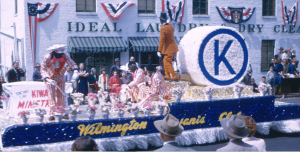
Image #47-1953, Azalea Festival Collection, New Hanover County Library Digital Collections
This semester (Fall 2014), students in all four sections of HIST 395: Research Methods will participate in a pilot project. Each student will create an individual domain via WordPress that will serve as a portfolio site. Today they will make their first “real” posts, which should consist of a primary source used in their papers plus a brief analysis of said source. I’m posting this image from my own research to illustrate the goal. It is used in chapter four of a book manuscript titled, “Deep Currents: Race, Place, and Memory on Wilmington, North Carolina.”
Taken in 1953, it shows members of the Wilmington (NC) Kiwanis Club on their float in the city’s annual and much celebrated Azalea Festival. It clearly shows four men in blackface, the ‘Kiwanis Minstrels.’ One of them wears a top hat and a bold, golden-yellow plaid suit; the other three wear outlandish red-and-white striped suits with oversized red bow ties. In earlier chapters, I explore how and why minstrelsy became popular in the 1830s and 1840, why it appealed to white residents, and how its unique forms and tropes persisted into the twentieth century. Through their costumes and antics, the white men on this float deployed old stereotypes of blacks as ignorant buffoons tolerable only for their entertainment value. The Kiwanans’ own place in society, derived by way of cultural inversion, is as the community’s enlightened governors. That such a prominent organization represented its identity this public way confirms the prevalence of racist attitudes among white civic leaders in the 1950s and their conviction that the audience (which they imagined as white) shared their views. In these and other ways, I argue that the Azalea Festival helped perpetuate the ideal of white supremacy and the illusion of “harmonious” race relations.
